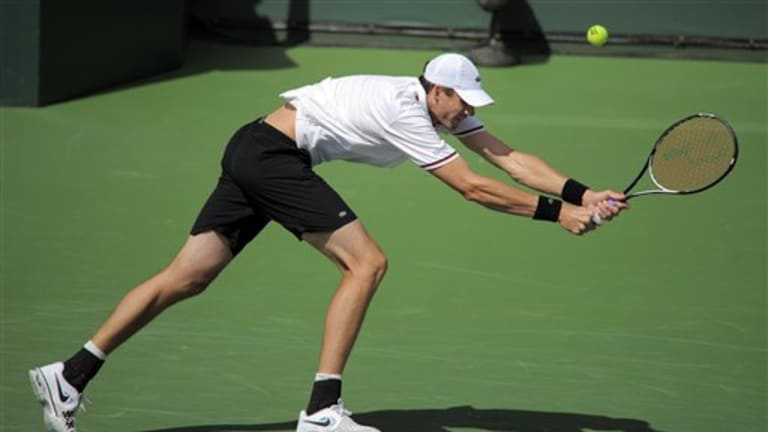by Pete Bodo
It used to be that the ranking cliché in tennis was the tendency to lump together the entire class of players who were particularly good on a dirt as "clay-court specialists," even though the more accurate description would have been "clay-court experts." One striking proof that this is indeed a different game from the one played 10 or 15 years ago is that the players to whom that mildly perjorative description could be applied are, like classic serve-and-volleyers, almost extinct.
There has been a comparable misconception (even if it can't be summed up in so popular an expression) and subsequent evolution when it comes to the big men in tennis, and what you might call the "big man's game."
In the stone age, big men (6-foot-3 and taller) were apt to hit booming serves (remember when the big, flat one was called the "cannonball" serve?) and then rush to the net. In the more recent bronze age, big men paid more attention to the prudent option of learning to hit some other shots as well (the overhead, which used to be called the "smash," doesn't count as one of them), but their main ambition was still to tickle the newfangled speed gun and produce eye-popping ace counts.
But those banner ace days are relatively few and far between when you pore over the statistics produced by the likes of the prominent big men afoot today, like Marin Cilic, John Isner, Gael Monfils, Robin Soderling, Juan Martin del Potro, Tomas Berdych, Sam Querrey, Milos Raonic, and Kevin Anderson. Among them, Anderson comes closest to playing what you might call the classic, big man, ace-based game. To say that del Potro's great asset is his ability to hit aces tells us no more these days than saying Roger Federer's great asset is his topspin backhand. It may be true but it misses the point.
True, four of the top five ace-makers in 2012 are big men. The odd man out is, surprisingly, No. 12 Nicolas Almagro, who ranks fourth. Almagro was probably perched on tippy-toes and a phone book when he produced his "official" height of 6'0" for the ATP Media Guide. To make the point even sweeter, this is a guy who in the not-too-distant past might have been described as a "clay-court specialist."
Anyway, Raonic is the top ace producer, followed respectively by Isner, del Potro and Berdych. I've been thinking about this "big man tennis" subject since the Indian Wells final, and two related statistical details that emerged from it. The first is that Isner had an excellent first-serve conversion rate—in fact, at 73 percent, it was a whopping 10 points better than Federer's, yet Isner won "only" 71 percent of his first-serve points. By contrast, Federer was 33 of 35 when put his first serve in play, for an outstanding 94 percent conversion rate.
Federer didn't win that match in spite of Isner's serve; he won it because of his own.
More interesting, Federer had seven aces to Isner's four, which tells you at least two things when you also look at the first-serve conversion rates: Federer probably was going for more—way more—on his serve than was isner. And whatever Isner was trying to do, it had nothing to do with raining down enough aces to smother Federer and make Ivo Karlovic smile.
Isner's game plan was less-ace based than driven by the desire to use the delivery as a tool to achieve less obvious ends. And that's never been what we think of as "big man tennis." Remarking on the number of big men in tennis today and how it has impacted the game, the poster known to you as Slice-and-Dice recently wrote in an email:
In a fine example of "the law of unintended consequences," this slowing of the surfaces has played into the hands of big men, in that the higher bouncing and topspin-heavy shots land right into a big man's strike zone. Besides, we all know how difficult it can be for big and tall folks to, basically, bend over—a talent that was a pre-requisite for success at Wimbledon back in the day. As Slice noted, the only big man who was a Grand Slam champion and consistent top-tenner in the Pete Sampras generation was 6-foot-5 Richard Krajicek.
So it may be that the changes in the game have helped the big man whose serve can strike fear in the heart of any rival, but in a way that has less to do with the always valuable ability to belt aces than more subtle aspects of the game.
Isner's height, and the advantage it gives him when serving, has led may fans and pundits to suspect that were it not for those natural blessings, he might not be anywhere near as good a player. Some might even think, "Hey, if I were that big and could serve like that, I'd be a great tennis player too!" Others think there's something unfair to men of average height to have to play against such big men.
But the reality seems to be that big men in general succeed because of how good they are at the "little man game," even though their atomic serves enable them to pursue that conventional game from an advantageous position. That, incidentally, is becoming Isner's trademark to an even greater extent than his comrades, probably because he's also weaker than those other men in some key areas, including mobility.
Isner's game plan isn't to win pre-emptively, or even to smother, with his serve—although if it starts going that way, nobody in is right mind, including Isner, would change tactics. Isner wants to use the advantage of being 6-foor-9 to dictate, or to put him in position to control and end the point before the disadvantages of being 6-foot-9 catch up with him.
In other words, inside John Isner is a little man, dying to get out.
